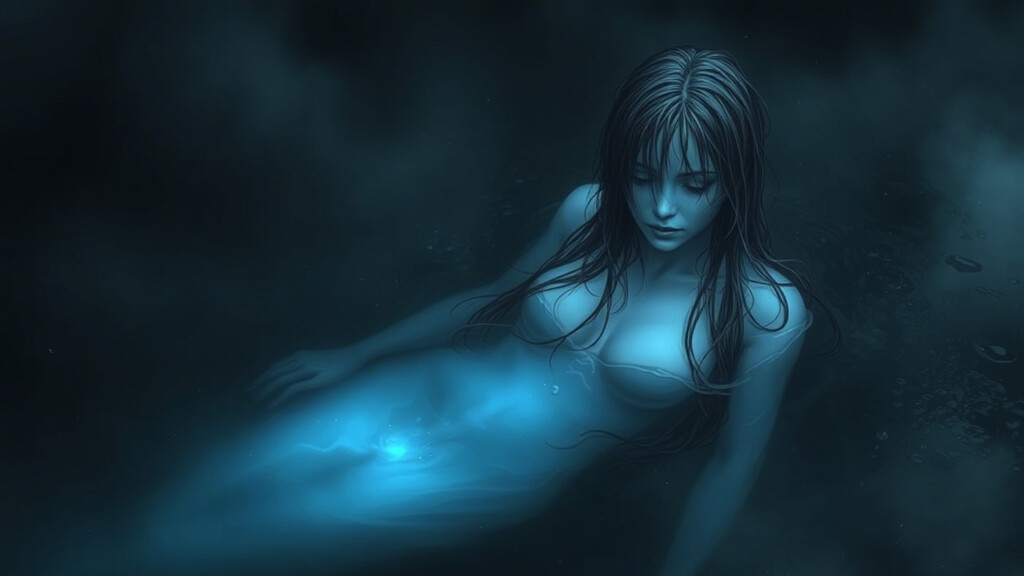Night falls over the Han River, and city lights shimmer on the water’s surface. At first glance, the scene is peaceful. But close your eyes, listen carefully… Do you hear whispers rising from the depths? In Korean folklore, they might be the sorrowful voices of Mul Gwishin—spirits of the drowned, forever trapped between life and death, burdened with loneliness and an eerie longing for release.

Mul Gwishin – More Than Just a Water Ghost
Mul Gwishin is not merely a ghost of drowned souls. It embodies fear, extreme isolation, and the darker recesses of the human psyche. According to folklore, those who perish in water under unjust or tragic circumstances, without proper rites, remain as restless spirits wandering rivers, lakes, and seas. Unable to move on, they seek solace in a chilling way—by pulling the living into the depths, hoping for a replacement.
The image of Mul Gwishin reflects a deep belief in the spirit world, where the boundary between life and death is fragile. Water, the source of life, can just as easily become a cold, merciless grave.
A History of Tragedy – From War-Torn Past to Folkloric Fear
Stories of Mul Gwishin have haunted the Korean consciousness for generations. Jibong Yuseol (지봉유설), a 17th-century encyclopedia by scholar Yi Su-gwang, recorded the persistent fear among those living near water—an ever-present dread of vengeful drowned spirits. But the origins of this fear run even deeper.
Korea’s turbulent history, marked by brutal wars and relentless natural disasters, has witnessed countless lives swallowed by water. The Imjin War (1592-1598) is one such example. Thousands of soldiers—both Korean and invading forces—perished in rivers and seas. Many of these bodies were never recovered, never given proper funerals or prayers, leaving their spirits to linger, fueling tales of ghostly apparitions.

In Korean folk beliefs, water holds a unique position. It is both a giver of life and a symbol of the unknown, a gateway to the afterlife. The Dragon King (용왕 – Yongwang), the deity of the seas, is both a protector and a harbinger of misfortune. Thus, Mul Gwishin is not just the spirit of the drowned but also a manifestation of nature’s unpredictable, mystical power.
Science’s Attempt to Decode the Fear
Modern science has attempted to explain the terror surrounding Mul Gwishin. “Water-induced hallucinations” are a documented phenomenon—when oxygen deprivation or extreme cold affects the brain, swimmers can experience the sensation of being pulled down or even see illusions. This could partly explain the eerie stories of ghostly hands reaching from the depths.
But what about the other sensations? The fear of abandonment, the overwhelming loneliness, the feeling of drowning in despair? These emotions, too, are part of the Mul Gwishin legend. Psychological studies on aquaphobia (fear of water), grief, and isolation in modern society provide clues to understanding the deeper fears that give Mul Gwishin its terrifying presence.
Haunted Places – Where Folklore Meets Reality
Mul Gwishin is not confined to old stories—it lives on in real locations across Korea, places where the line between legend and reality blurs:
- Mapo Bridge (Seoul): Nicknamed the “Suicide Bridge,” Mapo has witnessed countless tragic deaths. Some say an unseen force calls out to those standing on its edge, compelling them to jump. A young woman, standing on the railing one rainy night, gazes into the water. She does not cry, does not hesitate. There is only an eerie stillness—like she is already lost to the world.
- Seonam Lake (Jeolla): A tale tells of a beautiful maiden forced into an unwanted marriage. Rather than submit, she chose death in the lake’s embrace. Since then, villagers have reported hearing soft cries and whispers echoing from the water at night. “Ji-soo… Ji-soo-ah…” A fisherman, startled by the voice calling his name, turns around—only to find the lake eerily still.
- Incheon Sea: This coastal region is infamous for mysterious disappearances. Veteran fishermen speak of ghostly pale hands emerging from the depths, reaching for the unsuspecting.
Mul Gwishin in Modern Life – The “Drowning Tactic”
Beyond the supernatural, Mul Gwishin has infiltrated everyday life, reflecting the dark side of human interactions. The term “Mul Gwishin Jakjeon” (물귀신 작전)—the “Mul Gwishin Tactic”—describes the act of dragging others down into trouble to avoid blame or lessen one’s own guilt.
- In the workplace: A mistake is made. Instead of owning up, an employee blames a colleague, pulling them into the fallout.
- In relationships: A friend betrays another, but instead of remorse, they spread rumors to damage their victim’s reputation, ensuring they both suffer.
- In media depictions: The Glory and Penthouse vividly showcase the Mul Gwishin Tactic. In The Glory, school bullies torment Moon Dong-eun, then scramble to shift blame when their crimes resurface. Penthouse is filled with characters ruthlessly dragging each other down in a spiral of lies, greed, and envy. These characters use people as “life preservers,” ensuring that if they sink, they won’t sink alone.
Mul Gwishin – A Haunting Warning or a Reflection of Ourselves?
A shadowy figure beneath the water, a cold hand reaching out… Mul Gwishin has haunted Korean culture for centuries. But the most terrifying thing isn’t the ghost itself—it’s when Mul Gwishin manifests in real life, in toxic relationships, in human selfishness.
Perhaps you’ll never encounter a Mul Gwishin lurking in the river’s depths. But beware of the “Mul Gwishin” hidden among us—those who will drag you down to save themselves. The greatest horror may not be the spirits beneath the waves but the ghosts that lurk within the human heart.
And sometimes, in our loneliness and despair, we might become Mul Gwishin ourselves, harming others without realizing it. That is the true fear.
Do we have the courage to confront the Mul Gwishin within us?
